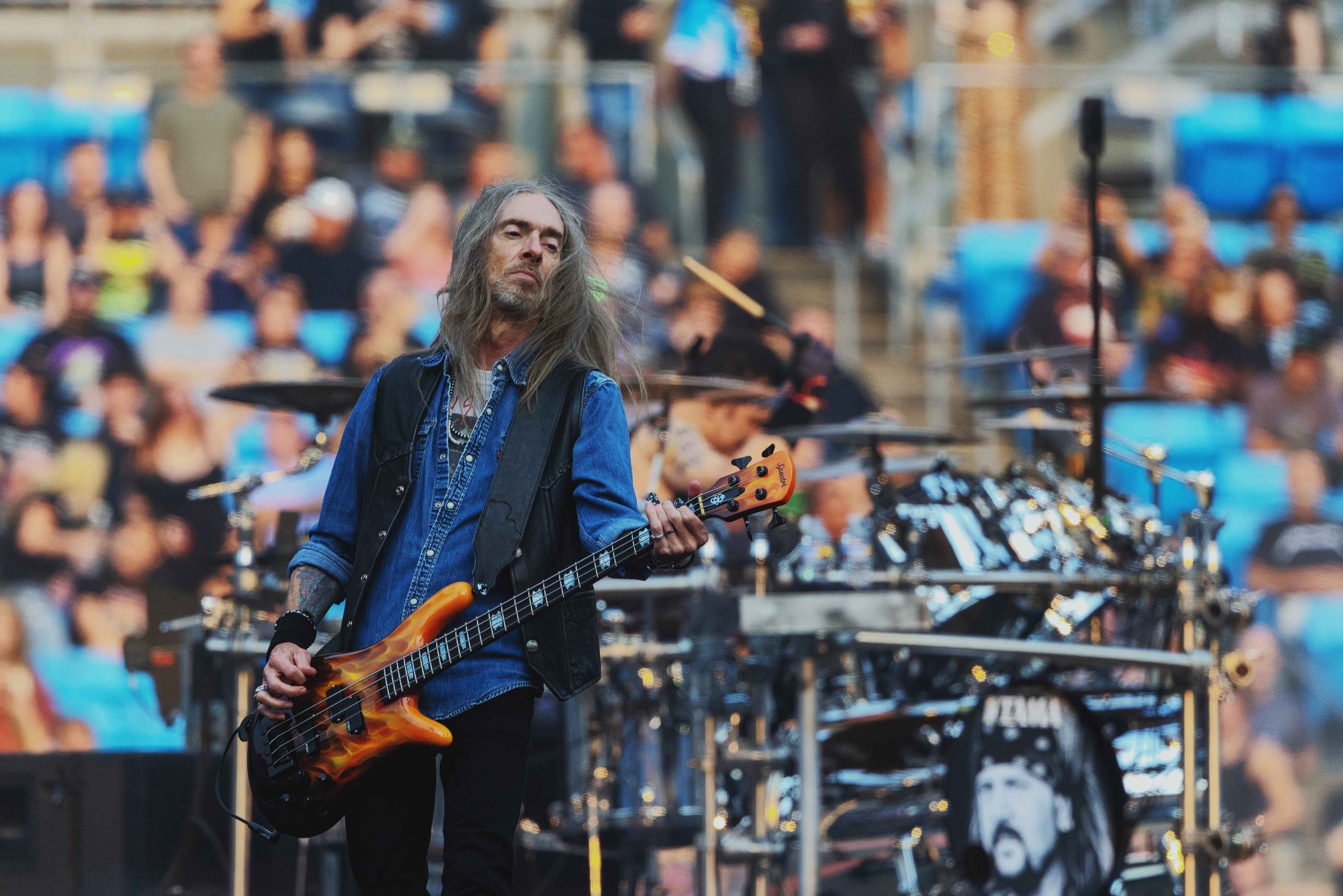Review: Metallica + Pantera at Bank of America Stadium
Metallica sure knows how to put on a show!
But so does Pantera, and even without the fancy video graphics, light show, or pyrotechnics that awaited in the headlining set, the openers nearly convinced the May 31 crowd at Charlotte’s Bank of America Stadium that they were the primary draw.
Traversing the giant circular stage in the middle of the field, bassist Rex Brown, guitarist Zakk Wylde (whose long locks somehow avoided entanglement with his Flying-V’s strings), and barefoot vocalist Phil Anselmo made multiple circuits, treating fans in every corner of the venue — as well as the middle “Snake Pit” — to passionate takes on “Walk,” “Domination,” “This Love,” and more. Meanwhile, Charlie Benante pounded away on his drums, but during a mid-set video tribute to dearly departed founding Pantera members Dimebag Darrell and Vinnie Paul, he too became mobile, relocating 180 degrees away to melt the faces of attendees who’s been staring at his back for the previous half hour.
The roar that erupted from the crowd as Pantera took its bows amidst the month’s final sunset made one think perhaps this band was the true fan favorite. But despite the riveting start to the night, considering the extraordinary number of Metallica T-shirts spread throughout seats accustomed to Carolina Panthers and Charlotte FC gear, there was no question whom folks truly came to see.
However, an overlong transition between the legendary heavy metal acts made one wish Pantera had never left the stage. As the main attractions walked in (technically, in, around, and under, accommodating the unusual elevated setup) to AC/DC’s “It's a Long Way to the Top (If You Wanna Rock 'n' Roll),” the video boards — which resembled high-tech New York City water towers — played a slideshow of photos from throughout Metallica’s storied history.
The fittingly badass choice then gave way to one of the evening’s most questionable decisions: an extended airing of the graveyard scene from The Good, The Bad, and The Ugly. Though Ennio Morricone’s epic music nicely complemented the grandiose vibe that the band was about to produce, the letterboxed video of Eli Wallach’s Tuco running between the rows of headstones made for squinty viewing on the already awkward circular screens and raised the question of just how long these poorly-planned shenanigans would last.
Within minutes, a large yellow-and-black drum kit mercifully emerged on stage where, seconds before, there was nothing, Lars Ulrich then took to walloping them in his textbook excited way, and James Hetfield (vocals/guitar), Kirk Hammett (guitar), and Rob Trujillo (bass) began their gradual marches around the infinite loop. As Hetfield oscillated counterclockwise between mics set up around the Snake Pit and the stage’s exterior, the quartet followed Pantera’s lead and even upped the ante, engaging their fans with dialed-in musicianship and a genuine thrill to be playing to such a massive (read: over 75,000 people) gathering.
Newer tracks “Lux Æterna” and “Screaming Suicide” blended well with such early-set hits as “For Whom the Bell Tolls” and “Ride the Lightning,” and were wisely positioned back-to-back near the middle so Metallica could get back to songs that even Martians know by heart. But first, fans were treated to the Hammett/Trujillo instrumental jam “Devil’s Lettuce" and Death Magnetic banger “The Day That Never Comes,” during which many in the audience — from GenXers down to preteens — took the opportunity to sit and recover from the opening stand-at-attention session.
The respite over, Hetfield ripped into the start of “Fuel,” accompanied by the night’s first blasts of literal fire as flames shot from the stage, high into the air, and brought the crowd back to its feet. The energy remained high during rousing instrumental “Orion,” which the lead singer dedicated to former Metallica bassist Cliff Burton, who was tragically lost nearly 40 years ago. And the ensemble continued to flex its versatility with beautiful slow(er) jam “Nothing Else Matters” which, along with the instrumental middle section of “Master of Puppets,” gets my vote for Metallica’s top contributions to society.
Throughout the show, Ulrich’s drums disappeared and reappeared in new quadrants thanks to multiple “magic tricks” enacted through modern-day smoke and mirrors (i.e. an extremely dark stage and distracting video screen antics). Onlookers might have believed it was the same drum kit, carted beneath the stage from one spot to another, except a closeup on the second location revealed a sticker that read “Drum #2.”
These brief breaks were the lone powers capable of disrupting the drummer’s incredible passion. Already plenty occupied with complex percussion parts, Ulrich seemingly sang along with every song, clearly elated to be in that exact place at that exact time, doing exactly what he was doing. Though Hammett’s intricate fretwork, Trujillo’s flying fingers, and Hetfield’s commanding presence were a joy to witness and elevated the performance, it was tough to deny that Ulrich is the glue that holds Metallica together and the force that propels it forward.
Gradually ramping up the bells and whistles, the promise of grand spectacle came to full fruition in the set’s final three selections, where lights, fireworks, and even giant beach balls (dropped from the “water towers”) meshed with singalongs to the choruses of “Seek & Destroy” and “Master of Puppets.” and a giddy rendition of “Enter Sandman” that further solidified it as the band’s greatest hit. The audience response might not have generated seismic activity like the Virginia Tech football team’s introductory anthem did at Metallica’s May 7 stop at Lane Stadium — or maybe it did? We’re still waiting on results from UNC Charlotte’s Applied Geophysics Lab — but the overall effect was nevertheless earth-rattling.
(Photos by Benjamin Robson)
Metallica
Pantera


























